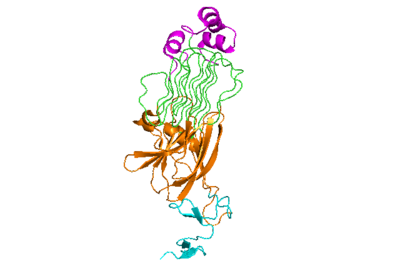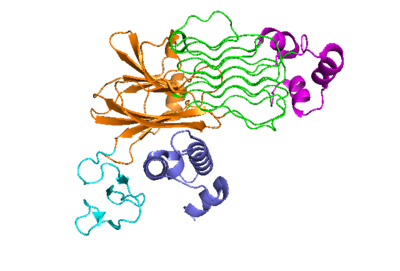Introduction
Anaplastic Lymphoma Kinase is a receptor tyrosine kinase and is an integral membrane protein. ALK transfers a phosphate group from ATP to a tyrosine residue on an enzyme which activates a signaling cascade, and ALK becomes activated when a ligand called ALKAL binds to the binding surface on an extracellular domain of ALK.
Structure & Function
Domains
The extracellular portion of ALK has an inactive state, which is its monomerized form, and an active dimerized state with its ligands bound. The monomer is shown to the right in Figure 1, which has many different domains. The growth factor-like domain (EGF) connects the extracellular domains to the transmembrane domain (cyan). The tumor necrosis factor-like domain (TNFL) has a beta-sandwich structure that provides important residues that act as the binding surface for the ligand (orange). The glycine-rich domain (GlyR) contains 14 rare polyglycine helices that are hydrogen-bound to each other (green). The of these rare helices create a very rigid structure that is important for ALK function. The polyglycine extension loop (PXL) connects two of these polyglycine helices (pink).

Figure 1: The ALK monomer unbound to ALKAL. Cyan: growth factor-like domain (EGF). Orange: tumor necrosis factor-like domain (TNFL). Green: glycine-rich domain (GlyR). Pink: polyglycine extension loop (PXL).
The domains that aren't shown in Figure 1 but are shown in the domain map (Figure 2) that also make up the monomer are the heparin binding domains (HBDs), which are at the N-terminal end of the monomer. Heparin has been found to be a possible activating ligand of ALK. The transmembrane domain (TMH) are the residues of ALK that are located within the membrane. The kinase domain is the intracellular portion of ALK that contains the Tyr residues which are auto-phosphorylated when ALK is activated, initiating a signaling cascade.
Conformational Change
In order for the Anaplastic Lymphoma Kinase (ALK) to move across the membrane to bind with the second monomer, it has to undergo a conformational change. The Anaplastic Lymphoma Kinase Activating Ligand (ALKAL) binds to the binding surface on the ALK. This induces a conformational change which allows for the PXL and the GlyR domains to hinge forward. [1] The kinase is now ready to move across the membrane and attach to the other kinase to be fully activated.
Movement across the membrane
The negatively charged phosphate groups on the cell membrane interact with the highly conserved positively charged residues on ALKAL ligand that face the membrane, which stabilizes the ligand to bind to ALK even better.
Disease
Relevance
Structural highlights
The active state of the kinase is when two monomers have completed a conformational change and moved across the membrane to form a .


